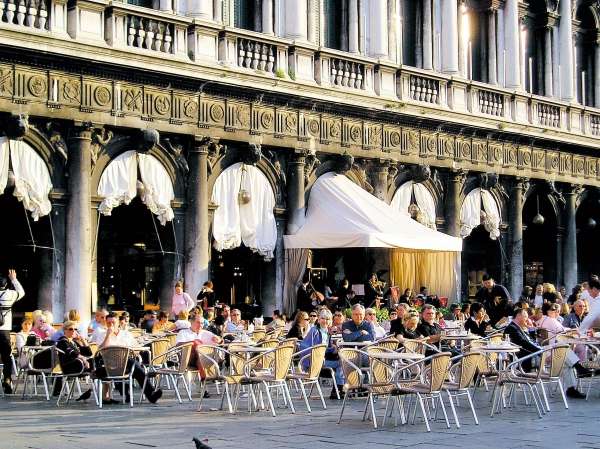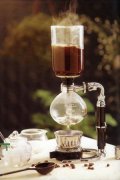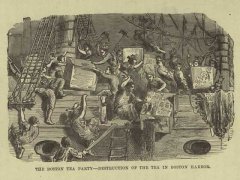The Coffee Culture feelings of the Fine Coffee City Vienna

Vienna is said to have more than 600 cafes, several of which are famous, such as Sach Cafe, Sperl Caf é, Hawelka, etc., but tourists prefer to visit the "Caf é Central", which has the most stories.
Walking into the coffee center, there is a statue of Adenberg, sitting in a chair with his hand on the coffee table. The writer writes in this cafe, meets Schnitzler, is appreciated, and walks into the literary world. Today, however, people are not familiar with his works, but most of them know a slogan: "I am not at home, in the coffee shop; not in the coffee shop, on the way to the coffee shop." This sentence was originally used to talk about the relationship between Adenberg and the Coffee Center, but it gradually evolved into Adenberg's master. If there are some literary cafes in the world that are willing to build a small blackboard at the door and write a famous literary quote, then Adenberg can be called the initiator. He once wrote a poem like this: "if you are depressed, no matter what, go to a cafe!" Your income is only 400 kroner, but you are willing to spend 500 dollars to go to a coffee shop! You hate the people around you and despise the people around you, but you can't do without them. Go to the cafe! "
I found four cat cafes on Montsio Street in Barcelona, and tourists kept stopping at the door to look at the small facade of the cafe and the poster by Ramon Casas. A middle-aged woman was responsible for guiding the tourists to their seats one by one, giving a very brief introduction to the history of the cafe.
Many tourists come for Picasso. In 1899, 17-year-old Picasso held his first exhibition in this cafe, and his paintings were used as the cover of the menu. In fact, the caf é is closer to Ramon Casas, a well-off painter who studied painting in Paris in his early years and returned to Barcelona to build his own party place like the Paris Black Cat (Le Chat Noir). His business partner is Pereromeu, who used to work as a waiter at Black Cat and is bent on setting up a good pub offering moderately priced dishes and good music. The "black cat" in Paris closed in 1897, before Picasso went there to see it, but the bohemian pub in Montmartre, Paris, has been handed down in Barcelona, and the "four cats" opened in June of that year. In addition to coffee, wine and food, Romeu believes that there is a "spiritual element" here, and his artist friends often sit together to discuss problems. In Spanish, "four cats" means three or five people. There have been architects Gaudi, musician Isaac Albenis, and so on. But it may be difficult for three or five friends to maintain a pub. Six years later, "four cats" also closed. Now the shop reopened in 1978, and admiring tourists are here to have a drink and have a rest.
In Spanish, there are three main types of coffee: cafe solo is black coffee, cafe cortado is with a little milk, and cafe conleche is with a lot of milk (Italian latte means milk). This is the origin of the so-called "latte". However, it was not the Italians or Spaniards who invented milk and coffee, but a Viennese named Kurjisky, who was a war hero in the war against the Turkish Empire in 1683. The city council rewarded him with a sum of money and a house, as well as a large amount of coffee seized from the Turkish army, so he naturally opened a cafe after the war. The English name means "Blue bottle Cafe". He dressed in Turkish national costume to serve customers and mixed milk with coffee. He must have boasted to customers that although we had learned to drink this black thing from the Turks, the Turks had no idea that it could be mixed with milk. The Blue bottle, which opened in 1686, must be one of the earliest cafes in Europe. The cafe closed after his death in 1694, but he is still regarded as a hero by Viennese. Every October, there is a Kurkisky festival, and Viennese cafe owners paste his portrait on the window. There is now a street in Vienna named Kurkisky, and there is a statue of him on the corner. I searched the Internet for the Blue bottle Cafe in Vienna and found that an American businessman registered the name in 2002 and opened his store from California to New York, perhaps the next Starbucks chain.
Important Notice :
前街咖啡 FrontStreet Coffee has moved to new addredd:
FrontStreet Coffee Address: 315,Donghua East Road,GuangZhou
Tel:020 38364473
- Prev

The History of siphon Pot for making Fine Coffee training Pot
In 1840, a glass test tube in a laboratory triggered the invention of the siphon coffee maker (Syphon). The British took the test tube used in Biya's chemical experiment as a model to create the first vacuum coffee pot. Two years later, Mrs. Bachang of France improved the kettle, and the familiar upper and lower convection siphon pot was born. The siphon coffee maker lived in France for a long time.
- Next

The Cultural History of Fine Coffee an important era in American Coffee History
Coffee training Culture: an important era in American Coffee History 1652-the first coffee shop opened in Britain, when the price of a cup of coffee was a penny; now the average American price of an Espresso-based coffee drink is $2.45; and in 1773-after the Boston Tea Party, the Continental Congress declared coffee the official national drink of the United States. Today, on average, every American
Related
- How did the Salvadoran coffee industry develop in Central America?
- What exactly does the golden cup extraction of coffee mean?
- The Origin of Coffee flower
- [2023 Starbucks World Earth Day] there are more meaningful things besides free Starbucks coffee!
- What kind of coffee is there in Spain? 9 Flavors of Spanish Coffee
- Aromatic African coffee| Kenya's coffee culture and historical production area
- Liberica Coffee Bean knowledge: the characteristics of Liberian Coffee beans of the three original species of Coffee beans
- The origin and formula of Spanish latte introduces the taste characteristics of Bombon coffee in Valencia, Spain.
- How to adjust the solution of over-extracted coffee
- What is the tasting period of coffee beans? What is the period of coffee and beans? How should coffee wake up and raise beans?

